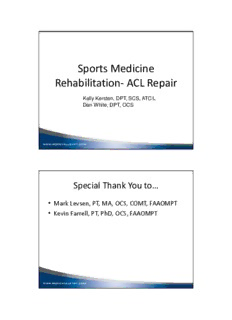
Sports Medicine Rehabilitation- ACL Repair PDF
Preview Sports Medicine Rehabilitation- ACL Repair
Sports Medicine Rehabilitation- ACL Repair Kelly Kersten, DPT, SCS, ATC/L Dan White, DPT, OCS Special Thank You to… • Mark Levsen, PT, MA, OCS, COMT, FAAOMPT • Kevin Farrell, PT, PhD, OCS, FAAOMPT Objectives • Description of injury, and • Demonstrations of ROM common mechanism of techniques. injury. • Demonstrations of strength • General time-line for and proprioception rehabilitation. progression. • Understand criteria based • Functional testing progression measures. • Precautions with rehabilitation. ACL Injury Partial vs. Complete Rupture • What defines the need for surgery? – Meniscal involvement – Presence of pivot shift – Age • What are the pre-surgical rehabilitation goals? • What influences the graft choice? – Allograft vs. autograft, HS, BPTB Mechanism of Injury • Contact: a blow to the knee with the foot planted. A valgus collapse of the knee, with poor hamstring control due to weakness or above average flexibility. • Noncontact: Typically a sudden deceleration prior to change of direction/landing. This tear occurs with the knee close to full extension. Pre-Surgical Goals • Reduce knee swelling, protect the knee • Restore extensor mechanism • Talk to athlete and parent about return to play timelines • Spencer et al found as little as 20 mL of knee joint effusion caused an active extensor leg. Timeline for Phase I 0-6 weeks • Educate the athlete on surgical procedure. 6-8 weeks for tissue to heal. – Graft failure in first 6 weeks is usually at fixation site. Site should heal in 5-6 weeks. – The graft undergoes revascularization @ 4-6 weeks. – The graft is @ its weakest at 6-8 weeks. – Following 6 weeks, failure occurs midsubstance. Phase I Goals • Protect the surgical site • Decrease knee edema; control knee effusion to decrease reflexive inhibition of the quadriceps; ice, compression, elevation, and E-stim. • Restore passive knee extension. This will decrease the chance of arthrofibrosis. Examples of knee extension are… Phase I Goals Continued • Normalize WB and gait. Watch for rear-foot pronation, as this will place the tibia in internal rotation. – When is it appropriate for patient to walk independently? • Start muscle contractions, to slow muscle atrophy. • 0 – 90˚ AROM in first week. Prone heel height less than 5cm difference. Ball rolling for ROM Functional exercise for knee control and ROM • Involved knee is stationary leg (back leg) Functional exercise for knee and hip ROM • Involved leg can be swing leg for ROM purposes or stationary leg for stability purposes • In a group of normal PT students two-30 second bouts of forward leg swings improved SLR by an average of 15 degrees Phase I Continues • Prepare for functional activities when extensor lag is gone. • Encourage early WB to improve cartilage nutrition, increase quad recovery, decrease osteopenia, and peripatellar fibrosis. • Knee extension and Cyclopes lesions. Phase I Continues • Start eccentric quad strengthening @ week 3- 4. • Increase endurance through reps and cardio. • Advance proprioception from standing to movement-based (e.g. agility ladders, Bosu ball, and Air-ex). • Concepts of PL & AM bundles. • Goal is to have 0 – 120˚ with no anterior knee pain. Knee Extension • Passive vs. Active limitations. – Joint limitation. – Muscle guarding. • Hyper-extension. Phase I Strengthening • Distefano et al found side-lying hip abduction/clam shells to be best exercise for gluteal strengthening. • Single leg squats followed by single leg dead lift- best way of strengthening gluteus maximus. • Plank stabilization: watch for knee pain reproduction • Quad strength progression from isometric to eccentric Phase I Rehabilitation Exercise • Isometrics, boring but necessary! • Weight shifts, heel lifts, proprioception, plyo- sled. • Hip extension, standing 45’s, clam shells, HS curls on theraball, and single leg RDLs. • Gastroc- anterior/posterior tibial strength in closed chain. • Hamstring strength in closed chain unless HS graft was used. Soft tissue mobilization for ROM Patellar Mobilization & Self-Mobilization Phase I Rehabilitation Exercise Continued • Closed chain TE 0-35˚ of knee flexion. This position will enhance neural feedback through joint compression. Decreased patellofemoral strain. • Open chain TE 90-40˚ of knee extension to decrease tibial shear. Reilly et al found peak PF force occurs @ 36˚. Shear force on ACL @ 30˚. • Proprioceptive drills. Start slow with 2 LE WB.
Description: